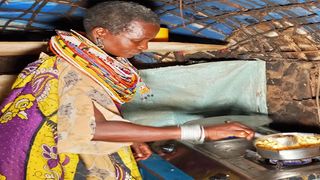
Katelina Lekanta cooking with gas from the Flexi Biogas system in a manyatta at her home in Archer’s Post, Samburu County.
| Nicholas Komu I Nation Media GroupSamburu
Premium
Samburu villagers ditch firewood for cleaner biogas
On the foothills of Matthew Ranges in Wamba, Samburu County, the setup and layout in manyattas and kitchens has changed.
The smoky outlook in the manyattas has started to disappear.
The absence of smoky kitchens and constant chopping of firewood is a unique characteristic for a remotely rural area as Wamba and the locals have a new form of biogas technology to thank for.
The adoption of biogas for cooking is not only money, time and environmental saver for the Samburu community, but also a lifestyle changer.
“Life has changed for us because the time we used to spent gathering firewood and charcoal from the mountains can now be directed to other productive activities,” Jane Lekaldero of Wamba area says.
With the partnership of Integrated Management of Natural Resources for Resilience in Arid and Semi-Arid Lands (IMARA), a consortium of Northern Rangelands Trust and World Vision, communities in Samburu are fast switching their reliance on wood for fuel to the cleaner source of energy.
Unlike the traditional biogas digesters, the Flexi Biogas incorporates modern technology and use of locally available and household materials making it is easy to set up and use in a domestic setup.
Its build and functionality are also different as it requires no excavation or concrete construction like the traditional system.
“All you need is a flat surface and the Flexi Biogas digester that comes with pre-fitted parts,” Robert Wanjiku, a technician working with the programme, explains.
Christine Lolngojine feeds slurry into a biogas system at her home in Wamba, Samburu County. The Flexi Biogas incorporates modern technology, use of locally available household materials, making it is easy to use in a domestic setup.
The main part of the system is a 6,000-litre black tube made from tarpaulin, a thick waterproof, flexible material often cloth coated with a plastic layer.
The tube is laid on a flat surface and then a greenhouse structure is set up on top of it as a cover. The purpose of the covering structure is to induce heat using the greenhouse effect as the black tubing traps in heat enabling efficient digestion of the sludge.
Dissimilar to past versions of biogas digesters, this system does not have chambers built within it. Instead, it uses a push mechanism where sludge fed from an opening on one end gradually pushes the one in the tube to an opening on the far end.
The system runs on biodegradable materials such as animal dung, kitchen, food and even garden weeds.
“Every day 20 kilos of sludge is fed in from one end of the tube.
As it sits in there in the heat, it will ferment producing methane gas. The methane rises to the top side of the tube where it is collected through tubes and piped into the house,” Wanjiku explains.
As more sludge is fed into the system, the digested sludge settles at the bottom and will be pushed out of the other end. Usually, the sludge pushed out is odourless and can be used as manure in the farm.
Efficient
A 20-kilo bucket of any waste will produce cooking gas enough to cook for a homestead of about six to eight people per day.
For Mrs Lekaldero, the introduction of biogas has not only helped her save time, it is also beneficial to her health and has helped in the recovery of already destroyed forests.
“I spent so many days in the hospital because the smoke from firewood was affecting my eyes. Now the pain is gone and I can see better. Besides, the community around has already started adopting the technology and that has reduced the number of trees destroyed for firewood and charcoal,” she says.
At Archer's Post on the Samburu-Isiolo border, Selina Lekanta and Katelina Lekanta have also installed the system in their manyatta home. The small manyatta that doubles as a kitchen and bedroom was previously uninhabitable due to the smoky wood.
“I am a cleaner woman now and my clothes do not smell of smoke anymore when I am out in public. And now I can focus on my beadwork and still come home and make supper for my family in time,” Ms Selina Lekanta says.
Since the communities in this region are mostly herders, dung is available in plenty. The introduction of biogas is also pushing some of them to venture into agriculture.
Jane Lekaldero cooking with gas from the Flexi Biogas system at her home in Wamba, Samburu County.
“The sludge that comes out of the digester is very good for crops so I use it on my farm as manure. In this area, dung is readily available but we did not know it could be a source of fuel. Now I just want to see everybody using it because it is very clean and efficient,” Mrs Lekaldero adds.
At the same time, for nomadic pastoralists, the system is ideal as it is portable.
Through the IMARA programme, about 130 homes in the Namunyak Conservancy area have already been fitted with the cooking gas, taking advantage of their herds of livestock to source for dung.
“We were looking for a programme that can support both the community and reduce the strain on the environment. Since the community depends on livestock keeping, biogas was very viable,” Mr Sammy Lesaita, the programme leader, told the Nation.
The system goes for Sh75,000 but through the IMARA programme, families only pay Sh30,000 through a two-year period.
“Every month they pay a standard Sh1,250 fee. Besides being a subsidy, the Sh30,000 they pay goes into a revolving fund which we use to install the biogas system for other families,” Mr Lesaita says.
The programme, launched three years ago, was geared towards reducing over-reliance on environmental resources for household fuels.
Mr Reuben Lekaldero, an elder in Wamba, says the aim is to restore the Mathew Ranges ecosystem to its old thriving form.
“When I settled here, I found a clean environment so my joy will be to see my children and future generations enjoy the same clean environment,” Mr Lekaldero says.




